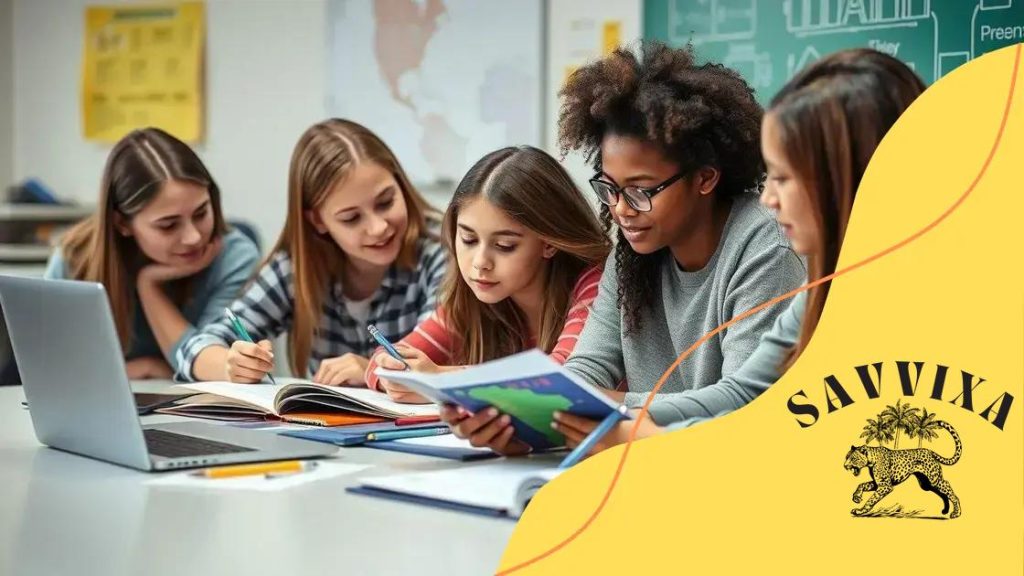Financial literacy education for teens: Why it matters

Financial literacy education for teens equips them with essential money management skills, enabling informed financial decisions that lead to a secure and responsible financial future.
Financial literacy education for teens can open doors to a brighter future. Have you noticed how many young people struggle with money management? This article explores practical strategies to help teens develop essential financial skills.
Understanding financial literacy: A teen’s perspective
Understanding financial literacy is crucial for teens today. It can be challenging for young people to grasp concepts like saving, budgeting, and investing, especially when they’re just starting to manage their own money.
Financial literacy equips teens with vital skills they’ll use throughout their lives.
The Basics of Financial Literacy
At its core, financial literacy involves understanding how to manage money effectively. This includes recognizing how income, expenses, and savings interact. By grasping these fundamentals, teens can make better choices.
Why It Matters
Financial decisions made in adolescence can have a lasting impact. Teaching teens about finances can help them avoid common pitfalls, such as falling into debt. Key reasons why financial literacy is important include:
- Building a solid financial foundation.
- Enhancing decision-making skills.
- Encouraging responsible money management.
Financial literacy can also help teens gain confidence. The more they know about finances, the more empowered they feel in making choices. This confidence translates into better financial behaviors as they age.
Engaging Teens in Financial Topics
To effectively teach financial literacy, it is essential to engage teens in discussions. Using real-life examples makes the concepts more relatable. Sharing stories about budgeting for a new phone or saving for a video game can create interest.
Additionally, incorporating technology can capture teens’ attention. Apps for budgeting and personal finance games provide interactive ways to learn. As they explore new tools, teens are exposed to smart financial habits.
By focusing on relevant topics and using engaging methods, we can foster a deeper understanding of financial literacy among teens. The goal is to prepare them for a future where they can navigate their finances with confidence and responsibility.
The impact of financial education on future success
The impact of financial education on future success is significant. When teens learn about money management early, they are more likely to thrive as adults. Understanding how to budget, save, and invest lays a foundation for lifelong financial well-being.
This education shapes their attitudes toward money. Teens who grasp the basics of financial management tend to make wiser choices later in life.
Building Good Habits
Developing good financial habits early can deter poor decision-making down the road. Teens who learn to manage their money effectively often:
- Set financial goals with confidence.
- Avoid debt traps by understanding credit.
- Know how to save for emergencies.
With these skills, they become more responsible adults. They learn to view money not just as a means of spending but as a tool for achieving their goals.
Direct Link to Career Success
Directly linking academic performance and financial literacy is vital. Teens who excel in managing their finances frequently demonstrate enhanced critical thinking and problem-solving skills. These traits contribute to better academic results, which can lead to higher education opportunities.
Moreover, understanding finances can influence career choices. For instance, teens who appreciate the value of financial independence may pursue higher-paying jobs or entrepreneurial ventures.
Through financial education, they gain the tools to navigate their paths. Ultimately, students who grasp these concepts often turn into financially savvy adults.
Practical steps for teaching finances to teens

Teaching finances to teens can be rewarding and vital for their future. Practical steps ensure that the lessons learned are effective and engaging. By introducing key concepts in relatable ways, teens are more likely to grasp the importance of managing money.
One of the first steps is to introduce budgeting. Helping teens understand how to track their income and expenses lays a strong foundation. They can start by keeping a simple budget for their allowance or part-time job earnings.
Making It Interactive
Another effective method is through games and simulations. Engaging teens in activities that mimic real-life financial decisions can deepen their understanding. Here are some interactive ideas:
- Use budgeting apps designed for teens.
- Play board games that focus on finance, like Monopoly.
- Organize workshops that simulate investment scenarios.
These activities can make learning enjoyable while imparting crucial financial skills. As they experience these scenarios, teens learn to make thoughtful choices about spending and saving.
Incorporating Real-Life Examples
Real-life examples also help teens connect the dots. Discussing everyday financial situations gives them context. For instance, comparing prices while shopping or planning for a school trip can illustrate budgeting concepts.
Encouraging teens to set financial goals is another vital step. Whether it’s saving for a new gadget or planning a trip with friends, goals motivate them to manage their money wisely. As they achieve these goals, their confidence grows.
By interweaving lessons on budgeting, engaging activities, and real-life applications, teaching finances to teens becomes a powerful experience. They will be better prepared to navigate their financial futures with confidence and skill.
Engaging resources for financial literacy education
Engaging resources for financial literacy education can make a significant difference in how teens learn about managing their money. Using various tools, from apps to games, helps sustain their interest and encourages better retention of financial concepts.
One popular resource is budgeting apps. These user-friendly applications allow teens to track their spending in real-time. By visualizing their expenses, they can make informed decisions and adjust their habits accordingly.
Books and Online Courses
Books geared towards financial literacy for teens are also valuable. Many authors break down complex topics into digestible pieces, making it easier for young readers to understand crucial concepts. Additionally, online courses provide flexibility, allowing teens to learn at their own pace.
- Look for books that focus on budgeting, saving, and investing.
- Online courses available on platforms like Coursera or Khan Academy can offer structured learning.
- Consider podcasts that discuss financial topics in a relatable and engaging way.
These resources can spark lively discussions about personal finance, encouraging kids to ask questions and share their thoughts. This interaction reinforces what they learn.
Games and Interactive Activities
Incorporating games into financial education is another interactive method. Online simulators that mimic real-world financial scenarios can significantly enhance the learning experience. Teens love competition and play, making it an excellent way to teach important lessons.
By combining these engaging resources, financial literacy education becomes enjoyable and impactful. Encouraging teens to explore apps, read relevant books, and participate in interactive activities sets the foundation for a successful financial future.
Overcoming challenges in financial teaching
Overcoming challenges in financial teaching is essential to help teens develop essential skills. While introducing financial concepts can be an exciting journey, obstacles often arise that can hinder effective learning.
One common challenge is the perception that financial topics are boring or too complex. To combat this, it’s important to present information in a fun and relatable way. Using everyday examples helps make abstract concepts more tangible.
Engagement Techniques
Engaging techniques can capture teens’ attention and encourage participation. Some effective methods include:
- Utilizing real-life scenarios to explain budgeting and saving.
- Incorporating technology such as apps or online games related to finance.
- Organizing group discussions or projects that stimulate teamwork.
These interactive approaches help make learning about finances exciting and relevant.
Addressing Diverse Learning Styles
Another challenge is addressing different learning styles. Not every teen learns the same way, and some may struggle with traditional teaching methods. Adapting to various learning preferences is crucial. For instance, visual learners may benefit from charts and videos, while auditory learners might thrive with discussions and podcasts.
Offering a variety of resources ensures that all teens can engage and understand the material. Encouraging questions and discussions also creates a supportive environment where students feel comfortable sharing their thoughts.
By recognizing and addressing these challenges, educators and parents can improve financial literacy teaching. This not only helps teens understand essential concepts but also empowers them to take charge of their financial futures.
FAQ – Frequently Asked Questions about Financial Literacy Education
Why is financial literacy important for teens?
Financial literacy helps teens make informed decisions about money management, preparing them for future financial responsibilities.
What resources are effective for teaching finances to teens?
Interactive tools like budgeting apps, educational games, and real-life scenarios are great for engaging teens in financial education.
How can I make financial education more engaging for teens?
Incorporating games, discussions, and relatable examples can make learning about finance fun and relevant.
What challenges might arise when teaching financial literacy?
Common challenges include overcoming misconceptions about finance being boring and addressing different learning styles among teens.